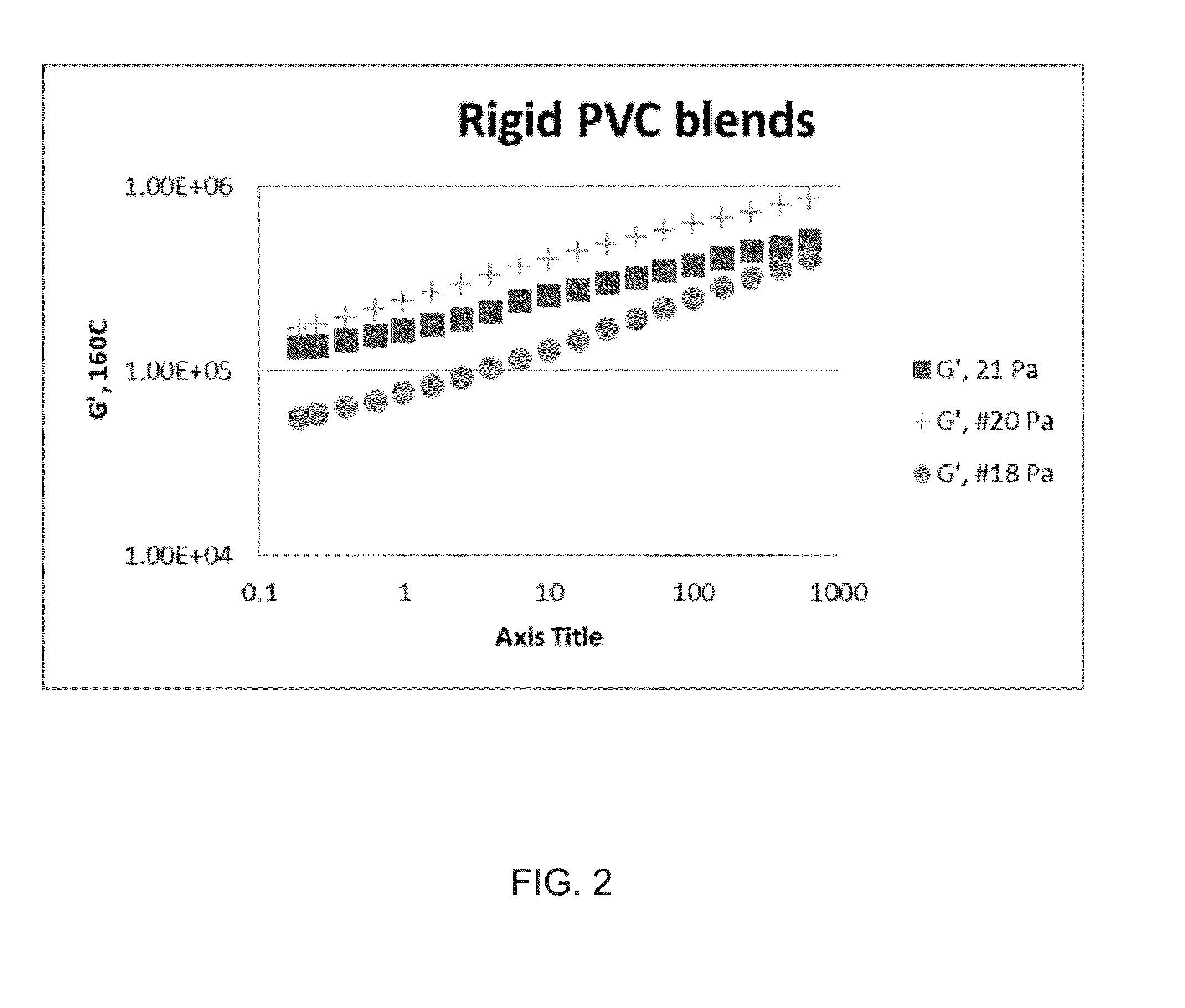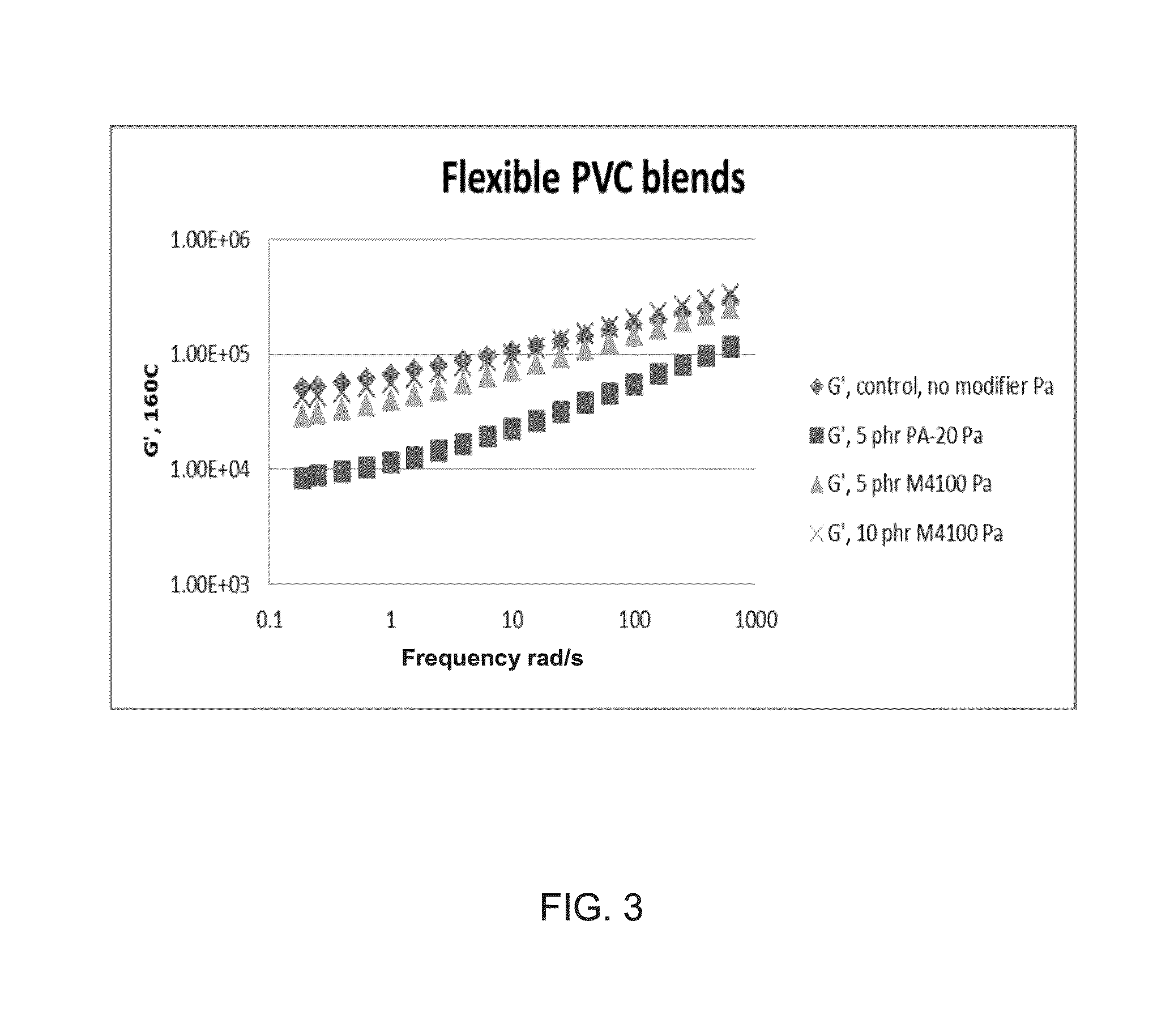Biobased modifiers for polyvinylchloride blends
a polyvinyl chloride and biobased technology, applied in the field of biobased modifiers for polyvinyl chloride blends, can solve the problems of inability to produce new products that were not economical or foreseeable, problems such as the integrity of the composition, and the longevity of products, so as to improve the weathering and/or permanence of the composition, improve the uv stability, and improve the stability of the produ
- Summary
- Abstract
- Description
- Claims
- Application Information
AI Technical Summary
Benefits of technology
Problems solved by technology
Method used
Image
Examples
example 1
Addition of a Rubbery PHA Copolymer to Rigid PVC
Effect on Thermal, Mechanical and Melt Properties
[0180]In this example, PHA E, a rubbery 30% 4HB copolymer, was added to a rigid PVC formulation (0% DIDP plasticizer) @28 phr (20% by weight) and the effect on the impact properties of the blend were evaluated. Table 3 summarizes the thermal and mechanical testing results for this blend.
TABLE 3Summary of mechanical and thermal properties of a rigid PVC / 0%DIDP / PHA E @28 phr blend.PropertyFormulation 1Tg (° C.)32.3Tensile Modulus (MPa)1407Tensile Strain @break (MPa)102Tensile Toughness (J)3.31Flexural Modulus (MPa)1202Low Temperature Brittlenesspassed(5° C.)Izod Impact Strength (ft lb / in)>18Shore D Hardness66
[0181]The results in Table 3 show that the rubbery PHA E was completely miscible with the PVC as evidenced by the single Tg value measured by DMA analysis. Since pure PVC has a single Tg at approximately 70° C., the results in Table 1 also indicated that the rubbery PHA E was very effe...
example 2
Addition of PHA to Rigid PVC
Effect of Thermal Stabilizer Package
[0185]In this example, changes in the impact strength for a rigid PVC / PHA blend versus the type of PVC thermal stabilizer incorporated are compared. The PVC resin used to prepare the samples was OXYVINYLS™ 240 a high molecular PVC with K=70. The PHA used was the amorphous or rubbery copolymer, PHA F, having a %4HB content of 30% by weight. The samples for impact strength testing (Formulations #20 and #32) were prepared according to the procedure described previously. Formulation #20 shown in Table 5 was prepared using the liquid BaZn stabilizer, M4781A (Galata Chemicals), having a Ba / Zn ratio=5.7 and a 5.33% by wt. phosphorus containing compound while Formulation 32 was stabilized with a solid BaZn salt of unknown composition (NAFTOSAFE™ PKP1028, Chemson Polymer Additive AG) and a phosphite (Doverphos-HIPURE™ 4, ICC Industries). Both formulations contained the same amount of epoxdized soybean oil (secondary plasticizer / ...
example 3
Addition of Crosslinked PHA to Rigid PVC
[0187]In this example, PHA C (40% amorphous rubber P3HB-4HB with 28-32% by wt. 4HB) and H (100% amorphous rubber P3HB-4HB with 55% by wt. 4HB) were crosslinked prior to melt blending with a rigid PVC polymer in order to enhance the impact modification properties of the PVC. Initially, PHA C and H were compounded with a peroxide initiator masterbatch consisting of 5% by weight T101™ peroxide blend with PHA B. For the compounding of PHA C or H with the peroxide masterbatch, a Prism, 16 mm twin screw extruder operating @150 rpm was used with the following extrusion temperatures (inlet to outlet): 172° C. / 174° C. / 175° C. / 177° C. / 177° C. / 179° C. / 179° C. / 179° C. Following reactive extrusion, the crosslinked PHA C or H was formed into strands and cooled in a water bath set at room temperature. The strands were then dried and cut into pellets or cryogrind under liquid nitrogen into a powder. The final concentration of peroxide in PHA C and H was varie...
PUM
| Property | Measurement | Unit |
|---|---|---|
| Temperature | aaaaa | aaaaa |
| Temperature | aaaaa | aaaaa |
| Temperature | aaaaa | aaaaa |
Abstract
Description
Claims
Application Information
 Login to View More
Login to View More - R&D
- Intellectual Property
- Life Sciences
- Materials
- Tech Scout
- Unparalleled Data Quality
- Higher Quality Content
- 60% Fewer Hallucinations
Browse by: Latest US Patents, China's latest patents, Technical Efficacy Thesaurus, Application Domain, Technology Topic, Popular Technical Reports.
© 2025 PatSnap. All rights reserved.Legal|Privacy policy|Modern Slavery Act Transparency Statement|Sitemap|About US| Contact US: help@patsnap.com



